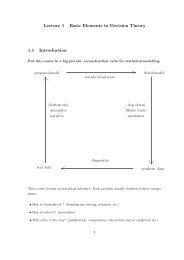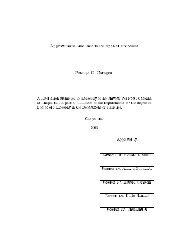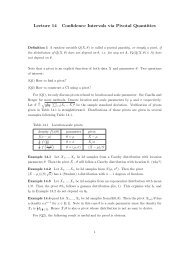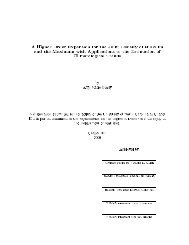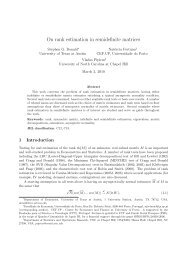Monte Carlo Methods in Statistical Mechanics: Foundations and ...
Monte Carlo Methods in Statistical Mechanics: Foundations and ...
Monte Carlo Methods in Statistical Mechanics: Foundations and ...
You also want an ePaper? Increase the reach of your titles
YUMPU automatically turns print PDFs into web optimized ePapers that Google loves.
Hamiltonian Hl;1 has the same functional form as the \ ne-grid" Hamiltonian Hl: itis<br />
speci ed by the coe cients 0 , 0 , 0 y, A 0 y <strong>and</strong> h 0 y. Thestep \compute Hl;1" therefore<br />
means to compute these coe cients. Note alsothe importance of allow<strong>in</strong>g <strong>in</strong> (5.23)<br />
for ' 3 <strong>and</strong> ' terms <strong>and</strong> for site-dependent coe cients: even if these are not present <strong>in</strong><br />
the orig<strong>in</strong>al Hamiltonian H HM, they will be generated on coarser grids. F<strong>in</strong>ally,<br />
we emphasize that the coarse-grid Hamiltonian Hl;1 depends implicitly on the current<br />
value of the ne-lattice eld ' 2 Ul although our notation suppresses this dependence,<br />
it should be kept <strong>in</strong> m<strong>in</strong>d.<br />
Basic (smooth<strong>in</strong>g) iterations. We have already discussed the damped Jacobi iteration<br />
as one possible smoother. Note that <strong>in</strong>this method only the \old" values ' (n) are<br />
used on the right-h<strong>and</strong> side of (5.9)/(5.10), even though for someofthe terms the \new"<br />
value ' (n+1) may already have been computed. An alternative algorithm is to useat<br />
each stage on the right-h<strong>and</strong> sidethe \newest" available value. This algorithm is called<br />
the Gauss-Seidel iteration. 17 Note that the Gauss-Seidel algorithm, unlike the Jacobi<br />
algorithm, depends on the order<strong>in</strong>g of the grid po<strong>in</strong>ts. For example, if a 2-dimensional<br />
grid is swept <strong>in</strong> lexicographic order (1 1), (2 1), :::,(L 1), (1 2), (2 2), :::,(L 2), :::,<br />
(1L), (2L), :::,(L L), then the Gauss-Seidel iteration becomes<br />
' (n+1)<br />
x1x2<br />
1<br />
=<br />
4 ['(n) x1+1x2 + '(n+1) x1;1x2 + '(n) x1x2+1 + ' (n+1)<br />
x1x2;1 + fx1x2]: (5.32)<br />
Another convenient order<strong>in</strong>g isthe red-black (or checkerboard) order<strong>in</strong>g, <strong>in</strong>whichthe<br />
\red" sublattice r = fx 2 : x1 + + xd is eveng is swept rst, followed by the<br />
\black" sublattice b = fx 2 : x1 + + xd is oddg. Notethat the order<strong>in</strong>g ofthe<br />
grid po<strong>in</strong>ts with<strong>in</strong> each sublattice is irrelevant [forthe usual nearest-neighbor Laplacian<br />
(5.1)], s<strong>in</strong>ce the matrix A does not couple sites of the same color. This means that redblack<br />
Gauss-Seidel is particularly well suited to vector or parallel computation. Note<br />
that the red-black order<strong>in</strong>g makes sense with periodic boundary conditions only if the<br />
l<strong>in</strong>ear size Ll of the grid l is even.<br />
It turns out that Gauss-Seidel is a better smoother than damped Jacobi (even if the<br />
latter is given its optimal !). Moreover, Gauss-Seidel is easier to program <strong>and</strong> requires<br />
only half the storage space (no need for separate storage of \old" <strong>and</strong> \new" values).<br />
The only reason we <strong>in</strong>troduced damped Jacobi at allisthat itiseasiertounderst<strong>and</strong><br />
<strong>and</strong> toanalyze.<br />
Many other smooth<strong>in</strong>g iterations can be considered, <strong>and</strong> can be advantageous <strong>in</strong><br />
anisotropic or otherwise s<strong>in</strong>gular problems [32, Section 3.3 <strong>and</strong> Chapters 10{11]. But<br />
we shall stick toord<strong>in</strong>ary Gauss-Seidel, usually with red-black order<strong>in</strong>g.<br />
will consist, respectively,ofm1 <strong>and</strong> m2 iterations of the Gauss-<br />
Thus, S pre<br />
l<br />
<strong>and</strong> S post<br />
l<br />
Seidel algorithm. The balance between pre-smooth<strong>in</strong>g <strong>and</strong> post-smooth<strong>in</strong>g is usually<br />
not very crucial only the total m1 + m2 seems to matter much. Indeed, one (butnot<br />
17 It is amus<strong>in</strong>g to note that \Gauss did not use a cyclic order of relaxation, <strong>and</strong> :::Seidel speci cally<br />
recommended aga<strong>in</strong>st us<strong>in</strong>g it" [36, p.44n]. See also [37].<br />
33



